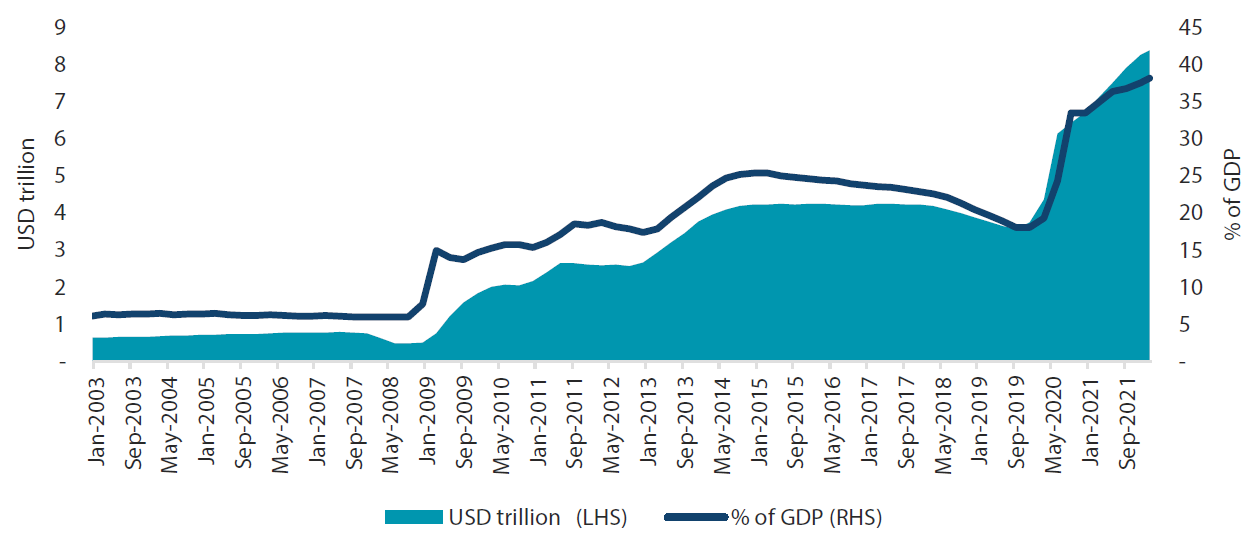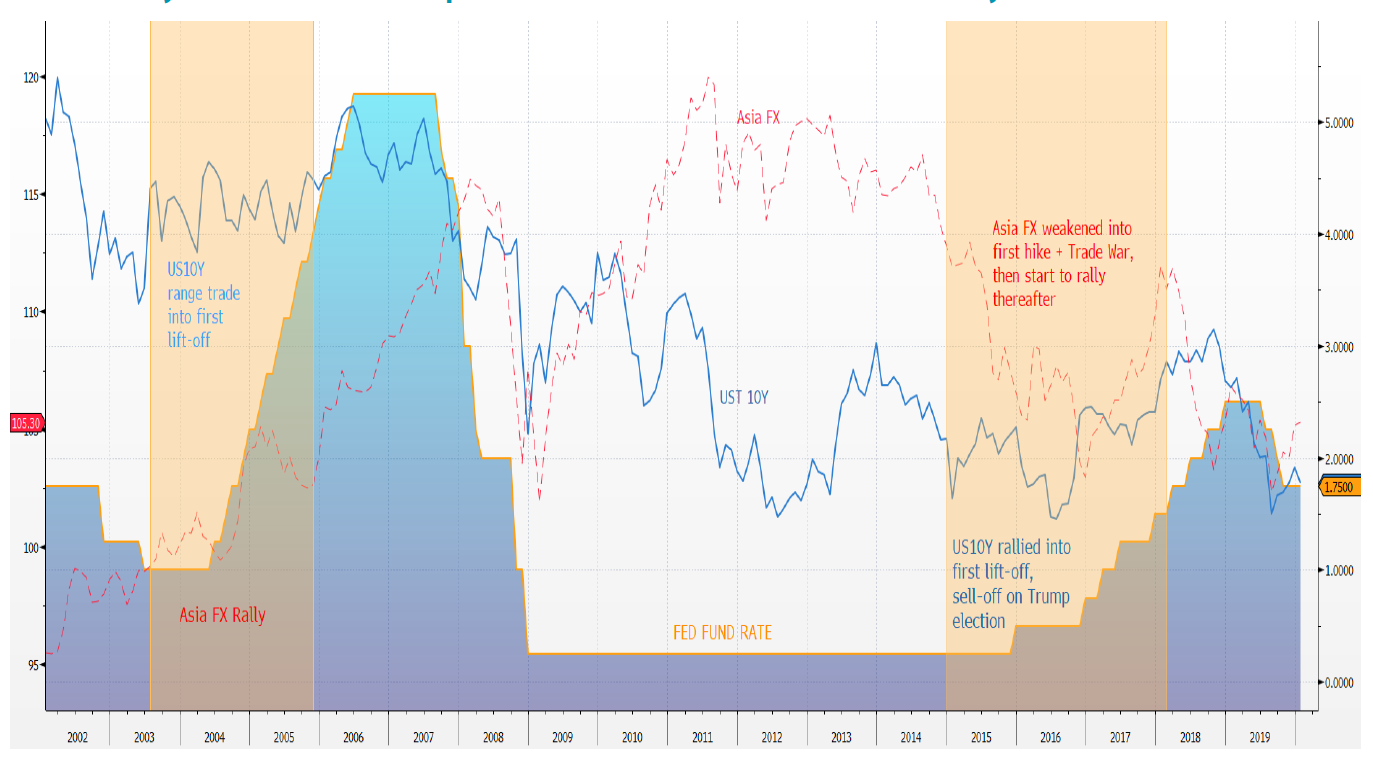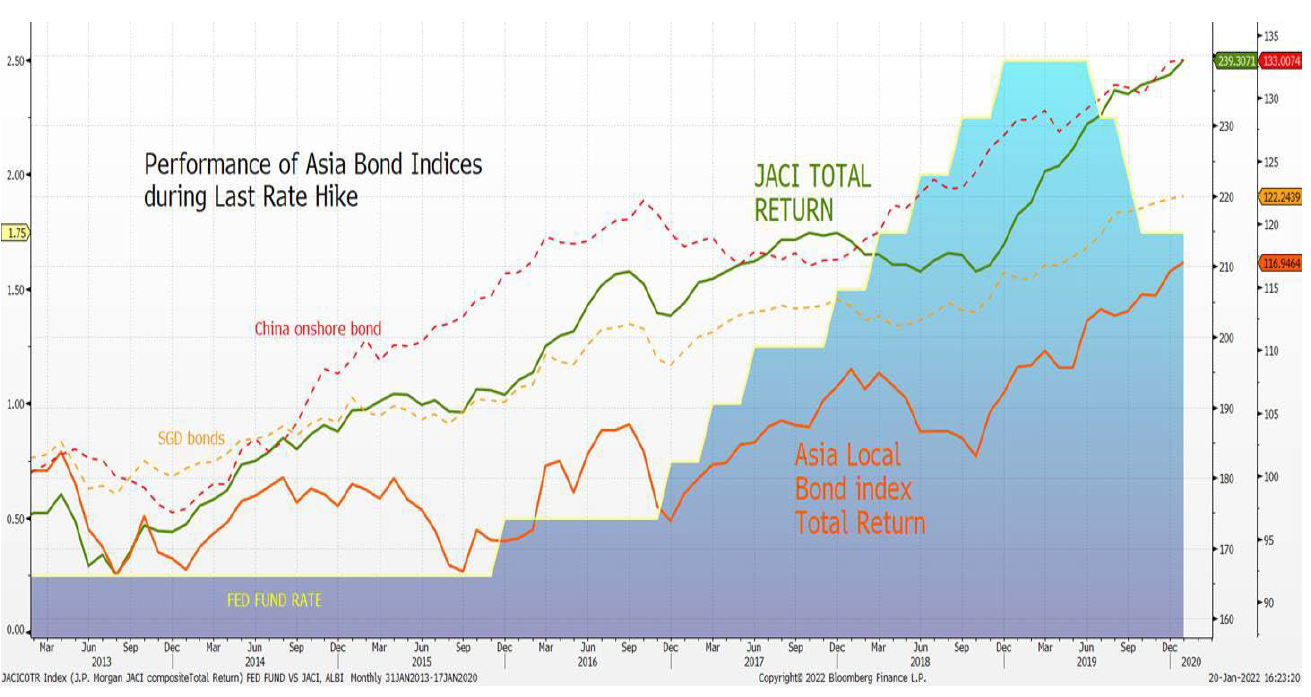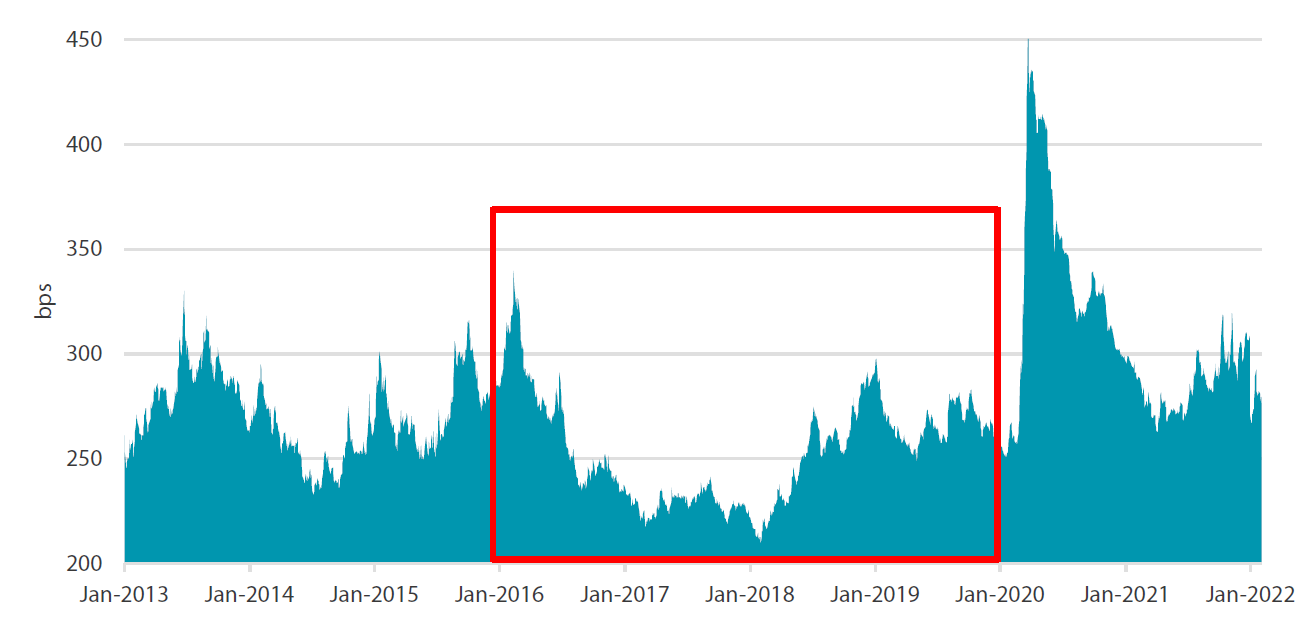The year 2022 started with the US Treasury (UST) yield curve bear-flattening and UST yields climbing across the curve. As of this writing, the 2-year, 5-year and 10-year yields have risen about 57.4 basis points (bps), 49.4 bps and 38.9 bps (as of 27 January 2022), respectively, since the US Federal Reserve (Fed) meeting on 16 December 2021. The sell-off is primarily led by increasing expectations of a more aggressive Fed tightening cycle. This was prompted by recent data reflecting persistent inflationary pressure and on the back of the December Federal Open Market Committee (FOMC) minutes which suggested that the Fed’s balance sheet runoff—when the central bank stops reinvesting proceeds from matured bonds—could begin in 2022, close on the heels of its first rate hike. As the Fed has accumulated a very large amount of assets on its balance sheet over the past decade (outstanding amount now at about USD 8 trillion, as seen in Chart 1), we think that it is reasonable for the central bank to act earlier rather than later, but clear communication will be crucial if it wishes to mitigate market volatility.
Chart 1: Assets on the Fed’s balance sheet

Source: Bloomberg, January 2022
Given increasing market concerns about the path of Fed normalisation and the impact on financial markets, we think that it would be worth revisiting the previous few episodes of Fed tightening for guidance. In the past two decades, there were two periods of rising US interest rates alongside improving US growth, shown in Chart 2.
Chart 2: 10-year UST and Asia FX performance in the recent Fed rate hike cycles

Source: Nikko AM, Bloomberg, January 2022
The Fed hiked rates by 425 bps between 2003 to 2006. During this time, UST yields were mostly bound in range. Meanwhile, Asian currencies (FX) rallied as the region’s improved macro stability allowed them to benefit from strong US demand without being hurt by rising US rates.
Between December 2015 and December 2018, the Fed raised its policy rate by 225 bps. It started raising interest rates in December 2015 and announced the runoff of its balance sheet in June 2017 (after raising the Fed funds rate for the fourth time). The actual runoff happened four months later. The Fed managed to shrink its balance sheet by around USD 500 billion before reversing its monetary policy in 2020 when the pandemic hit. USTs rallied into the first lift-off earlier in 2016 but started selling off towards the presidency of Donald Trump, who implemented a very large stimulus plan and overhauled taxes. At the same time, Asia FX weakened during this initial phase of higher UST yields, and sentiment towards the asset class deteriorated further on exogenous factors such as the US-China trade war.
However, as growth accelerated across much of the region, Asia bond markets (both credit and local currency bonds) generated positive total returns, as shown in Chart 3. In the case of Asia credits, spread tightening, together with returns from carry, more than compensated the rise in UST yields, allowing the J.P. Morgan Asia Credit Index (JACI) composite index to register positive total returns for the period (shown in Chart 4).
Chart 3: Performance of Asian bond indices during the last Fed rate hike cycle

Source: Nikko AM, Bloomberg, January 2022
Chart 4: JACI composite blended spread

Source: Nikko AM, Bloomberg, January 2022
What about the current cycle?
With the Fed’s current balance sheet tilted towards shorter maturities relative to the beginning of the previous normalisation episode, expectations of a swifter tapering process have thus had a pronounced impact on the 2-year and 5-year yields.
There remains significant uncertainty on the path to normalisation, and Fed communique will be keenly watched for more policy signals. For now, the market consensus is for the tightening to begin in March, with four to five 25 bps rate hikes in 2022, followed by two to three more in 2023. The Fed is also expected to start unwinding its balance sheet by mid-2022. The central bank could allow a faster pace of runoff relative to the 2014–2017 cycle, but we expect it to still implement the reduction in phases, just as it did in 2017. To mitigate the impact on interest rates and the economy, we anticipate that the Fed will announce a cap on the amount of USTs and mortgage-backed securities (MBS) that is allowed to “roll off” its balance sheet per month. Meanwhile, following the January FOMC meeting, we believe the chance of a 50 bps hike in March has increased.
We expect UST yields to continue rising heading into the initial rate hike and normalisation phase, but we are projecting a peak following greater clarity on the Fed’s tightening path and easing inflation in the latter part of the year. For now, we deem it prudent to maintain our strategy of underweighting duration in low-yielding countries such as Thailand, Korea, Singapore and Hong Kong, and keeping a more neutral duration in higher yielding countries due to the “carry cushion”. Meanwhile, we remain overweight on China bonds in the medium term as we expect the Chinese local currency bond market to outperform the region. The shift by the People's Bank of China to an easy policy stance, coupled with a resilient Chinese renminbi supported by robust exports, should provide strong support for Chinese government bonds, in our view.
While we are cautious on Asia ex-China local bonds in the near term, we note that foreign positioning in the Asian bond market is relatively light, limiting the risk of capital outflow. We expect the market to stabilise after the Fed unveils details of its balance sheet reduction plan. Thereafter, we expect differentiation in inflation and growth dynamics in various Asian countries to drive their individual performances for the rest of the year. Similarly, we anticipate a moderation in inflationary pressures in the latter part of the year, which could alleviate the upward pressure on yields.
Since June 2021, the dollar index (DXY) has traded steadily higher, appreciating about 6% following the Fed’s hawkish shift. As we head into a tightening cycle, we expect dollar strength to continue, especially on a rise in US real yields. As high energy prices persist, we are cautious towards the currencies of high net oil-importing Asian nations such as India and the Philippines. With the recovery in Asian economies, we expect the current accounts of countries such as Indonesia, the Philippines and India to slightly deteriorate from 2021 as imports rise, warranting a cautious stance towards their currencies.
In Singapore, amid a robust economic recovery, the Monetary Authority of Singapore started tightening monetary policy late in 2021 by strengthening the Singapore dollar (SGD) nominal effective exchange rate (NEER). We expect further strengthening of the NEER in 2022, which should support continued Singapore dollar outperformance. Notably, Singapore Government Securities tend to outperform their UST counterparts during periods of SGD NEER appreciation.
The SGD corporate bond market is dominated by issuers from government-linked corporates, financials, and real estate/Singapore REITs. Heading further into 2022, we remain broadly comfortable with SGD corporates as the Singapore government is moving toward treating COVID-19 as endemic. We expect the full reopening of economic sectors and borders to benefit our credit bond holdings. Banks’ capital positions are expected to remain robust, which should sustain their strong credit ratings even as they hunt for acquisitions to fuel growth outside Singapore. Meanwhile, Singapore property bonds provide a good source of portfolio stability in an environment marked by volatility in the Chinese real estate sector. In terms of bond structure, we prefer corporate perpetuals and financials with short call/reset dates (less than five years), as these offer higher carry over bullet bonds from the same issuer. Higher spreads are expected to help cushion the impact of rising rates. In addition, the likelihood of bonds being exercised increases in a rising rate environment.
Within Asia USD credits, the current spread of high-grade credits is tighter compared to the start of the previous rate hike cycle, reflecting stronger corporate credit fundamentals. However, this also translates to less buffer for investors against another round of risk aversion in markets. Hence, we deem it prudent to be underweight duration by holding shorter duration credits and hedging UST duration via UST futures (when permitted by fund mandate). We also favour some BBB-rated credits, particularly short callable bank subordinated debts, which offer relatively better spread buffers.






